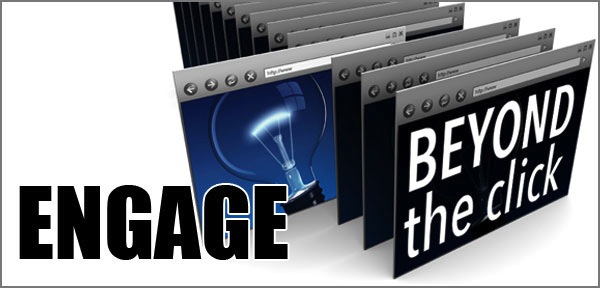
When we talk landing pages, most online marketers think pay-per-click, where the input of a destination URL into Google’s or Bing’s paid search offerings allow marketers to drive keyword-targeted traffic to (hopefully) optimized pages.
My previous article extolling the death of keywords talked about developing intent-based topics and building content that connects with those topics – intent to content.
We can now apply that mantra in a “first engagement” scenario, after a user clicks a search result, to ensure SEO landing pages:
- Connect with intent: Offering a user what they expect.
- Resolve (initial) user query: Answering their initial query.
- Engage the user: Sending user signals to search engines.
- Drive further user engagement (if necessary): Additional signals to both users and search engines.
A searcher intent to site content engagement scenario I call “CRED“.
In these scenarios where signed in users, search query modification, Chrome browsers, “cookied” users and toolbar data provide massive datasets of engagement signals to search engines on how users interact on sites, we need to drive optimal engagement scenarios.
Here’s a checklist of 10 “killer” tips to ensure you’re able to add a bit of CRED to your SEO campaigns, as well as demonstrate campaign success!
Connecting
1. Are the primary headlines aligned with intent?
The first thing users notice is content structure, headlines, headers, bolded elements, graphics etc. Your 2 seconds of opportunity to grab attention begins with a mental assessment that needs to immediately connect with the original search query and inspire additional engagement via clear communication of what the page is about.
Content should be created with specific intent in mind, with headlines, and/or graphic headers that are obvious, short, surrounded by adequate white space. And the content must be specific enough to inspire a user’s attention.
2. Are you matching content type with query intent?
If the target query includes “how to”, “best”, “top 10″, “compare” or other intent refining modifiers, or if the query demands a certain level of text content, are you obviously offering something that visually connects, confirms relevance, displays lists, video or images?
Users won’t have time to read, but they will make a quick decision on whether the format they review matches an expectation. For example, a query on top 10 bars should have a list with numbers displayed – or one entry with numbers. Or a query on the history of search should probably have an index and look robust – not just a 200 word paragraph.
Users have short attention spans, and most have a preconceived expectation of what they should find, not matching that initial expectation can equate to a quick “back click.”.
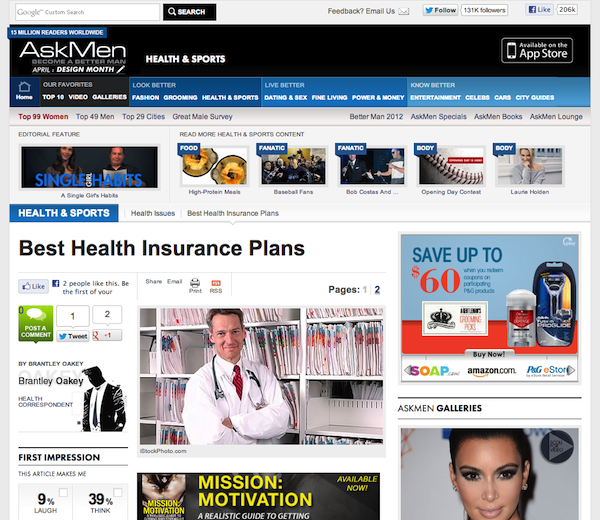
Query for “best health insurance plans for single men”. Ask Men offers a clear header and an image that immediately screams “authority”
Resolving
3. Can users perform a quick scan above the fold to answer who, what, and why?
As noted above, users don’t actually read on a first pass, they make a decision based on visual cues and click expectations (what they expect after they click).
Some websites fail in obviously reinforcing the click expectation, missing an opportunity for engagement, underscoring brand recognition, and providing obvious reasons of time-worthy value.
Click through to your site and ask the following:
- Is your brand obvious?
- Is it obvious what you do?
- Is it obvious why they should stick around?
Especially important with homepages, but equally important on other SEO landing pages, is ensuring your brand is obvious. Make sure what you do, or how you plan to address the user’s intent, isn’t buried. Give users obvious information and/or justification to stick around and/or click around is key to moving people to engage further.
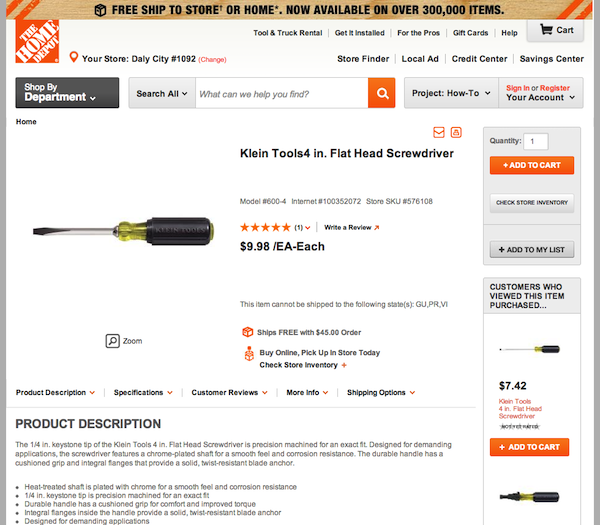
Query for “flat head screw driver”. Home Depot offers clear branding, white space to highlight product, and additional information that is clearly visible and offers visual cues that the tabs are clickable.
Remember: for instant user assessment of resolution potential, anything below the fold doesn’t exist!
Engaging
As noted with the Home Depot example, key engagement options exist such as an “add to cart” action button, search for intent refinement or modification, other options to dig into additional information and links to similar products that other customers have purchased.
Each of these elements contribute to answering the next question:
4. Is it obvious what they should do next?
For Home Depot, the answer is most probably yes. It’s easy to find the “Add to Cart” button, it’s placed in an obvious position and there’s multiple options to view additional information.
The product page offers multiple ways to engage, with a zoom button (subjectively probably not big enough), and plenty of other user-centric options such as writing reviews, checking inventory, etc.
Occasionally there can be too many options that can confuse users. In the Home Depot example there appears to be duplicated “check inventory” buttons/links, but these may have been tested and justified.
5. Are there on-page modification options? (based on query modification)
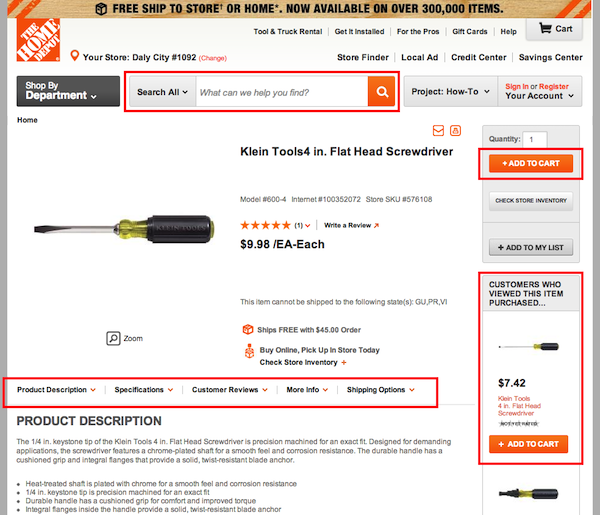
Home Depot offer a good example of obvious search functionality, related products, and other options that can help modify the user’s search query onsite rather than have them click back to the search results to modify.
These kind of onsite modifications do not always need to be driven by site search.
Breadcrumbs, side navigation, filters, related prods, color/size selection are all feasible options to mitigate click backs and improve onsite engagement signals.
Driving
6. Are ‘next clicks’ consistent?
Part of great site engagement is a consistent user experience for similar queries. By monitoring user interaction on a per query basis, website owners can identify consistencies or deficiencies in matches of search intent to site content.
Duane Forrester of Bing said in January 2013:
“In the long run, the brand names secure rankings through depth of content, trust in brand, and user interaction (searchers clicking a SERP result and staying on their site because the site is trusted and answers the searchers question)”
Providing key “next clicks” – obvious steps from landing pages to conversion or core information – is a better user experience = better potential rankability.
7. Can they share what they’ve found?
Probably the most obvious of tips, it the provision of social sharing and social connection buttons. If landing pages provide the value users expect, will they be inspired to share, and if they are, can they?
Sharing of a page is different than a click through to your social property (i.e., Facebook page or Twitter stream), and should be a key component on most landing pages, with the caveat of audience vs. social platform.
For pages with images, is there an option to share on Pinterest, Facebook, and Twitter? For business text content, is LinkedIn an option? Social signals are imperative in closing the loop on user intent satisfaction, demonstrating to both users and search engines an endorsement of your content.
8. Ultimately, can users find the banana?
Seth Godin published a book a few years ago called “The Big Red Fez” – rather than repeat all the key concepts, I can state simply is it’s all about bananas – users finding what they need from obvious choices. There’s an excellent synopsis here.
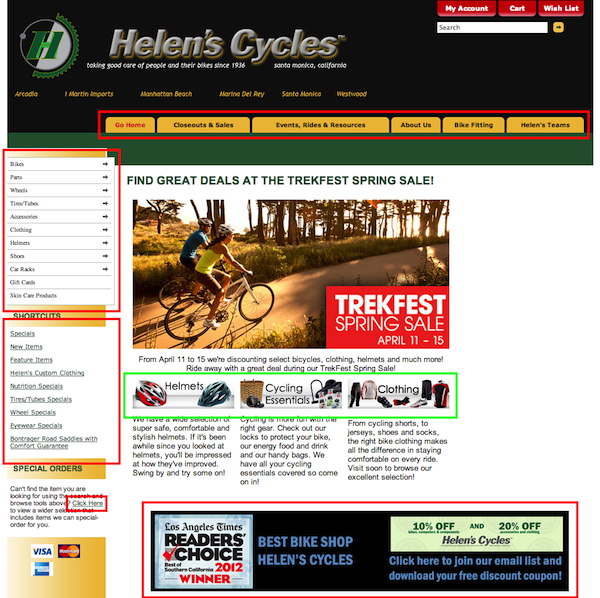
I love Helen’s Cycles, great stores and service. But visit their website and you’re presented with way too many choices (red) and a certain level of confusion (green). The green element talks about Helmets, Cycling Essentials and Clothing”¦ but offers no way to click or a link to relevant content.
Give your users clear navigation to improve consistent engagement and “banana-discovery.”
Measurement
The final two tips cover justification through measurement of metrics that matter.
9. Have you segmented traffic by topics?
Google Analytics offers segmentation by query topics through Analytics filters (beyond the scope of this article but more information can be found here) or by exporting data and consolidating offline in Excel.
Custom segments allow you to monitor performance across keyword query topics, understand topic traffic and conversion trends, and leverage this data to identify the key landing pages for each topic.
10. Are you tracking first click queries for optimized pages?
Although in an ideal scenario the page you optimize will attract the keyword queries you’d expect, custom segments by topic also offer up insights into competing pages (entry pages in your site that compete against each other), highlighting opportunities to consolidate similar pages, mitigating potential thin content issues and improving topic relevance on merged pages.
Utilize custom segments, organic traffic keyword query reports, together with landing page association to provide insights into potentially competing pages.

Music genre site, with custom “rock music’ topic filter applied, highlights the anomaly of “type of rock music” query being mapped to an Anime genre page. Worth investigating why?
Summary
Landing pages have historically been the domain of paid search marketers seeking improved conversion rates.
User experience, site usability, and onsite engagement have become more important for major search engines in their assessment of a site’s “rankability”, so SEO practitioners need to ensure SEO landing pages have CRED as a key to SEO success.





